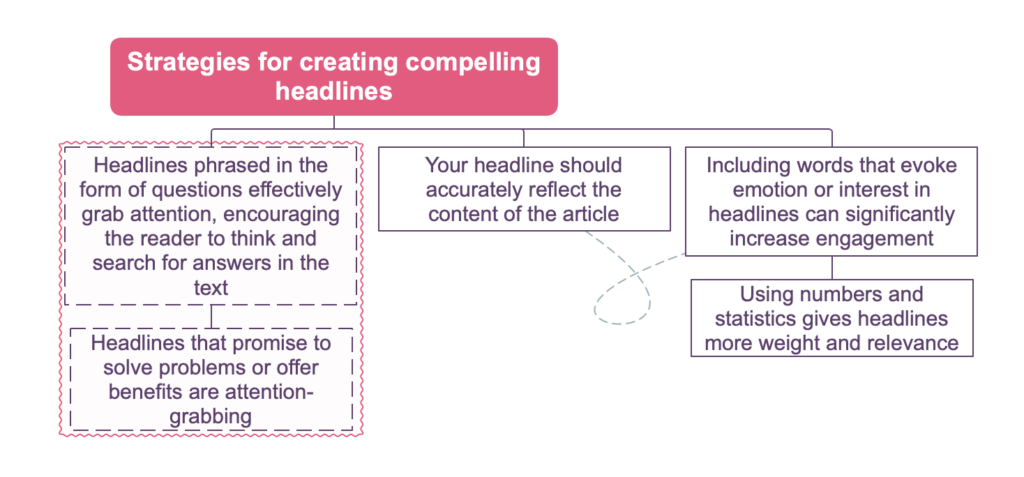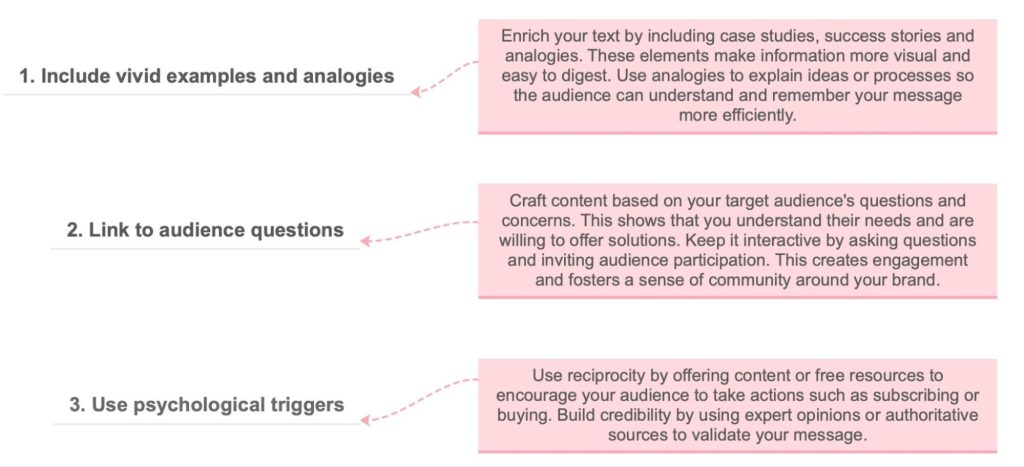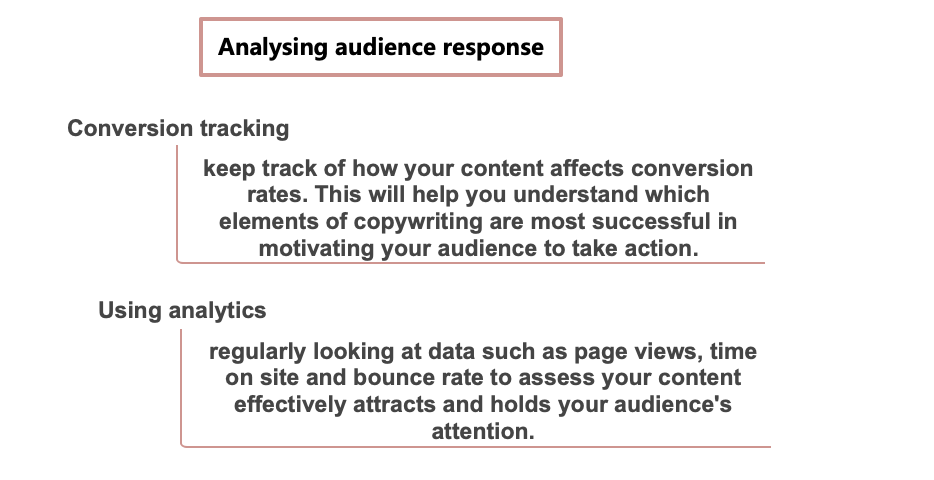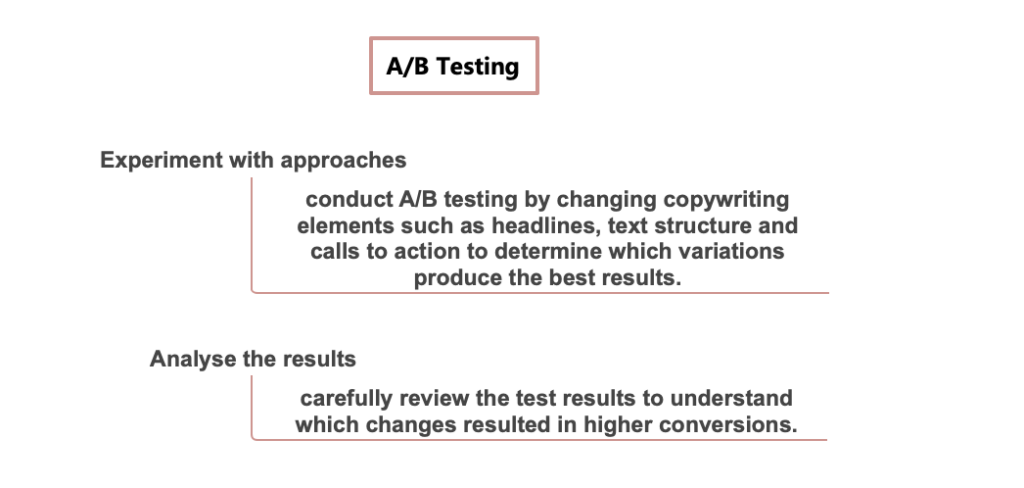Mastering the art of words
Why do some texts instantly grab attention while others go unnoticed? How do you turn words into a conversion-boosting tool? In this article, we’ll reveal the secrets behind copywriting techniques. These strategies will help you grab your audience’s attention and encourage them to take action.
Advanced copywriting is both an art and a science. It requires an understanding of your target audience, the ability to elicit a response and, of course, the ability to articulate your thoughts clearly and persuasively. This article will present proven methods and strategies that increase engagement and conversion without neglecting simplicity and accessibility.
Let’s dive into the realm of copywriting and learn how to create texts that are not only informative but also actionable!

The basics of advanced copywriting
Understanding your target audience is vital to success
What is the initial step in creating copywriting? The answer is simple: understanding your target audience. It is essential to know who they are, what they value, and what problems they’re trying to solve.
Think through the words and tone that will grab their attention and resonate with them. Your text should answer their questions. Offer solutions to their problems.
Create an emotional connection
Why do we often memorise advertising slogans or phrases from articles? Because they affect our emotions. Skilful copywriting knows how to play on the reader’s emotions. Use stories, metaphors and vivid imagery to evoke joy, hope, a sense of belonging or fear of missing out. When your message elicits a response, it becomes memorable and prompts action.
Clarity and specificity
It is imperative to be specific in your wording. Avoid using phraseology and clichés. Your goal is to convey the essence of your proposal to the reader. The simpler and more precise your message is, the more likely it will be heard and understood. Concise sentences often work better than confusing constructions.
Adaptability and flexibility of style
There is no one-size-fits-all copywriting style that works for everyone. You can adapt your style accordingly depending on the context and platform you’re posting on.
Whether you’re writing a report or a regular social media post, adapting your style to the context and meeting your audience’s expectations is essential.
Techniques for crafting attention-grabbing headlines
Why are headlines so important?
The headline of your content plays a vital role in grabbing your readers’ attention. It is a gateway to the article or message, determining whether people will continue reading. In an age of information overload, a compelling headline makes your content stand out from the rest.
Strategies for creating compelling headlines
- Including words that evoke emotion or interest in headlines can significantly increase engagement. Examples include words such as “revolutionary,” “secrets,” “revealing,” “remarkable,” and “exclusive.” These words create a sense of urgency and importance.
- Your headline should accurately reflect the content of the article. Including numbers, facts, or titles can make it informative yet compelling. For example, you could use “7 Proven Methods to Increase Conversions on Your Website”.
- Headlines phrased in the form of questions effectively grab attention, encouraging the reader to think and search for answers in the text. For example, have you ever wondered about email marketing mistakes?
- Using numbers and statistics gives headlines more weight and relevance. For example, “Learn about 10 new marketing trends for 2023” or “Achieve a 50 per cent increase in conversion rates with these proven techniques”.
- Headlines that promise to solve problems or offer benefits are attention-grabbing. For example, “Uncover strategies for generating leads at a lower cost.”

Strategies for increasing engagement
Engagement can be increased by using the following strategies:
- Use the power of storytelling to create engaging and memorable content. Stories establish a connection with your audience, making your message more personal and exciting.
- Provide information in content that not only informs but also offers practical value to the audience.
Here are some valuable tips to help increase the engagement and usefulness of your content:

How to prompt action? Optimisation to increase engagement
The call to action (CTA) is essential in converting reader interest into action in copywriting. Creating a CTA starts with providing clarity and specificity. Users must understand what is required of them, whether to purchase, subscribe to a newsletter, or click through to another page.
To make a CTA compelling, it needs to be in a prominent place. Easily accessible. Using contrasting colours and strategic placement on the page will help to grab attention and drive the user to action. At the same time, it is essential that the CTA fits seamlessly into the content and is an extension of it.
Psychological triggers in CTAs, such as creating a sense of urgency or offering a tangible benefit, are widespread in digital marketing to encourage immediate consumer action. Here are a few examples and practices adopted by companies:
- Netflix: They use the CTA “Try 30 days free” to offer new users a free trial, giving potential customers a taste of the service without any upfront payment.

- Manscaped: This brand leverages the “Get limited time offer” CTA to instil urgency, suggesting that the offer won’t last long and encouraging quicker decision-making from potential customers.

- Hello Fresh: They employ a countdown timer with the CTA “Claim offer” to add urgency and drive users to take immediate action to take advantage of a special deal.

- Shopify: Offers a 14-day free trial, creating a value proposition for users to try the service before committing to it.

- Forever 21: Uses “Get 20% Off” as a CTA to entice users to sign up for their mailing list, providing a direct benefit upon signup.

Using SEO in advanced copywriting
Search Engine Optimisation (SEO) plays no small role in copywriting. It consists of adapting content to increase its ranking in search engine results and making it accessible to the target audience.
Keyword integration is an aspect of SEO because it helps search engines understand and recommend your content to those looking for information. Here are some key points to keep in mind:
- Choose relevant keywords: use keyword research tools to identify the most relevant keywords to your content.
- Incorporate keywords naturally into the text: Incorporate keywords into your content without compromising readability.
Optimising headings and metadata:
- Creating SEO-friendly headlines: Incorporating keywords into headlines, making them not only attractive but also increasing their clickability.
- Captivating meta descriptions: Create concise and attractive meta descriptions that include keywords and accurately reflect the page’s content.
Analysing and testing
The most important aspect of copywriting is constant testing. Testing content to optimise conversion rates allows you to understand what is working effectively and identify areas for improvement or change.
Analysing audience response

A/B Testing

Final thoughts
To summarise our copywriting research, skilful use of language can impact increasing conversions and engagement. We learnt how important it is to understand your target audience, use techniques embedded in SEO strategies and be creative when creating content.
It’s important to note that copywriting goes beyond sales. It involves making connections, telling stories and evoking emotion. Your words have the power to inspire, educate and motivate. Use this ability to create content that attracts attention and prompts action.
Now is the time for you to enter the realm of copywriting with innovation and creativity! Your words can change society – so start making a difference today.
